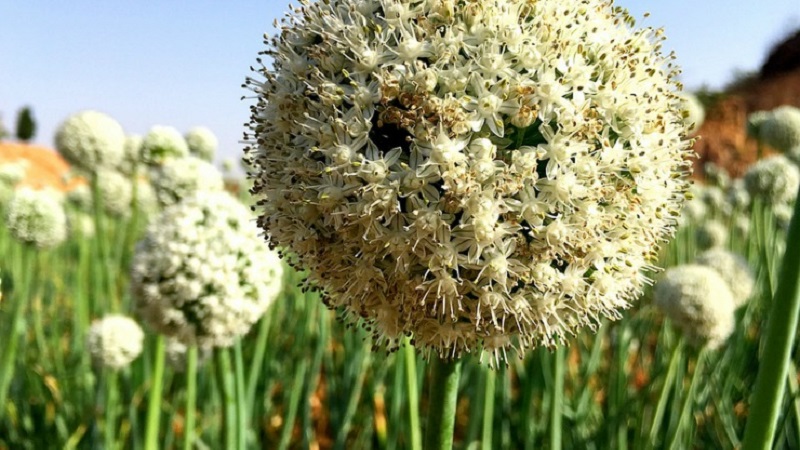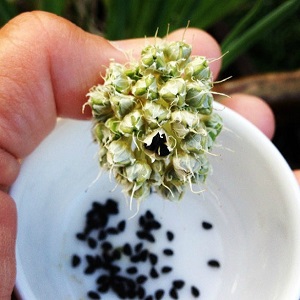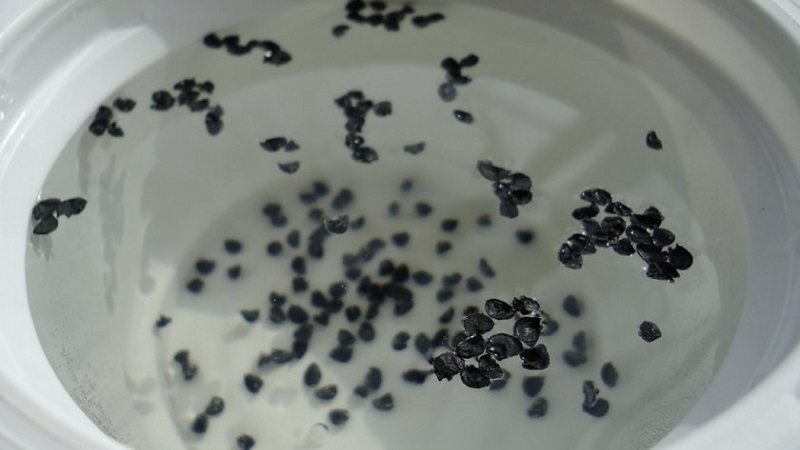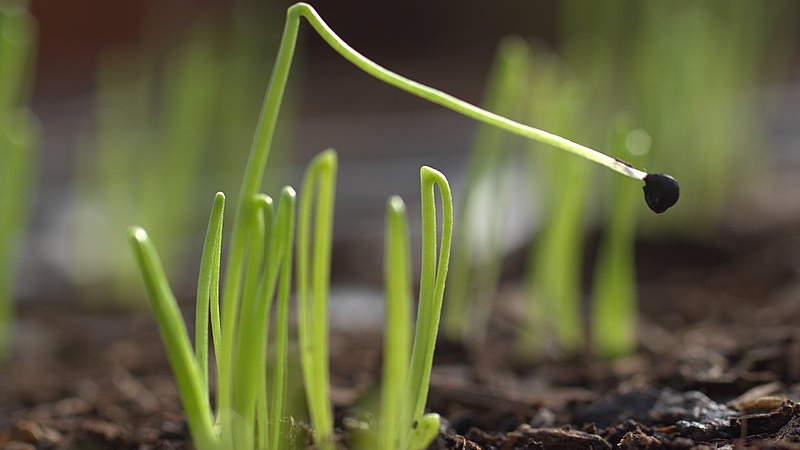How to grow Chernushka onions from seeds
Nigella is sometimes mistakenly confused with a separate onion variety. In fact, this is the name of the vegetable seeds, from which the seed is obtained for further cultivation. Any type of onion can be obtained from nigella seeds, depending on the bulbs from which the seed was taken.
The content of the article
Description
Blackies ripen in spherical flowers that grow on the arrows of an adult bulb... Seeds are obtained from seeds - seed material for growing onions in the second year. The name comes from their black color. Nigella look like ribbed seeds about 2 mm in size. They are purchased in specialized stores or assembled on their own.

Many types of onions are suitable for making sets. - for example, Rapture, Centaur, Crimson Ball.
Growing onions traditionally consists of 2 stages:
- In the first year, nigella seeds are sown, from which sevok (small bulbs) grows.
- In the second season, they plant sevok and get full-fledged vegetables.
Some varieties are planted before winter - they are suitable for harvesting in one year. These include Stuttgarter Riesen, Belovezhsky, Strigunovsky etc.
How to assemble
 Formation and development nigella seeds occurs in the arrows of ripe onions... Inflorescences appear on their tips at the end of crop growth. Then they are transformed into ribbed pods filled with seeds. The collection is carried out when they become brown.
Formation and development nigella seeds occurs in the arrows of ripe onions... Inflorescences appear on their tips at the end of crop growth. Then they are transformed into ribbed pods filled with seeds. The collection is carried out when they become brown.
So that the seeds do not crumble, the heads are tied with gauze... It is also permissible to cut the boxes and put them in a paper bag for ripening for several weeks. After the heads dry, they are vigorously shaken to release the seed material. The resulting nigella is stored in a dry and cool place before planting.
Chemical composition and useful properties
Bow and its juice popular in folk medicine — for the treatment of diseases they are used internally and externally, used in cosmetology to improve the condition of hair and skin.
The beneficial qualities of onions are due to their rich composition.... The vegetable is full of phytoncides, organic acids, sugars, natural antioxidants, enzymes, essential oils.
100 g of onions contain vitamins:
- PP - 0.2 mg;
- C - 10 mg;
- E - 0.2 mg;
- B1 - 0.05 mg;
- B2 - 0.2 mg;
- B5 - 0.1 mg;
- B6 - 0.1 mg;
- folic acid - 9 mcg.
Mineral content per 100 g of product:
- calcium - 31 mg;
- potassium - 175 mg;
- magnesium - 14 mg;
- phosphorus - 58 mg;
- chlorine - 25 mg;
- sulfur - 65 mg;
- iron - 0.8 mg;
- zinc - 0.85 mg;
- manganese - 0.23 mg;
- iodine - 3 mcg;
- copper - 85 mcg;
- fluorine - 31 mcg;
- boron - 200 mcg.
Onions have the following beneficial properties:
- Anti-inflammatory effect... It is used to treat colds and their accompanying symptoms (runny nose, cough, etc.).
- Stabilization of metabolic processes... The vegetable activates the digestive tract, stimulates the secretory function, lowers the level of cholesterol and glucose in the blood.
- General strengthening action... Antioxidants and other useful components contained in onions increase immunity, slow down the aging of the body, and reduce the risk of developing cancer. Strengthens bone tissue, blood vessels, have a hypotensive effect.
- Antiseptic and regenerating properties... Onion remedies accelerate wound healing, disinfect when applied topically (for example, when rinsing the throat).
- Decongestant qualities... Onions are applied externally or internally.
- Antiallergic effect... The vegetable acts as a natural antihistamine.
In cosmetology, onions are used against hair loss, for their nutrition and strengthening... The vegetable is used to treat acne, acne, freckles, and age spots.
Attention! Onions increase potency and reduce the risk of prostate cancer. In women, vegetable remedies are used to stabilize the menstrual cycle, local treatment of erosions, colpitis (inflammation of the vaginal mucosa).
Ripening period
The ripening period of a vegetable depends on its variety.. Onion varietiesgrown from nigella seeds are classified into:
- early ones - ripen in 90-115 days;
- medium - after 115-135 days;
- late - after 135-155 days.
The varieties of Stuttgarter Riesen, Crimson ball ripen earlier than others - the growing season is about 90 days, the Centaur onion harvest is harvested in up to 110 days, Delight ripens for 130-140 days.

Yield
Nigella, when properly collected and prepared, have a high germination rate... The plants are characterized by rapid development, little exposure to weeds. The vitality of the culture is noted.
This is due to the rich onion yield, while most varieties are early ripening. The amount of vegetables obtained also depends on the planting region.
Disease resistance
The process of sowing onions from seeds is considered natural, therefore allows the plant to fully adapt in the soil. The culture has an increased immunity to diseases and pests. Preventive measures, adherence to the rules of planting and care significantly increase the vitality of the onion.
Onion characteristics and taste
Varieties of onions grown from nigella differ in appearance and taste... For example, the Vostorg variety is characterized by large straw-colored bulbs weighing 150-300 g. There is a pronounced sharpness of taste. The Crimson Ball variety has a dark purple hue of bulbs. Their shape is round, their mass is small (80 g). The taste is semi-hot onion with sweet notes.
The Centaur variety is characterized by a yellow color, increased density, and a round shape. The taste is pleasant sweetish, suitable for people who cannot stand the traditional pungency of onions. Stuttgarter Riesen is a traditional light yellow color, has a flattened shape. Medium-sharp taste, no bitterness.
Demanding climate
Black onions are grown everywhere, since vegetables are characterized by unpretentiousness, high germination, yield.
Important! The timing of the harvest depends on the climate of the region. For example, the Stuttgarter Riesen variety in the southern regions will ripen already in May, in other areas - not earlier than June.
Onions do not like excessive moisture or drought.... For growing vegetables from nigella in unfavorable conditions, the Centaur variety is suitable. It perfectly withstands frost, drought and the effects of other negative factors. For red onions, southern regions are suitable.
The main advantages and disadvantages of the growing method
The advantages of the method include:
- profitability - buying sets for planting is more expensive than stocking up on seeds;
- early yield;
- resistance to diseases, pests, weeds;
- bountiful harvest;
- using a small amount of seed - a couple of bulbs are enough for one bed;
- unpretentiousness of plants, easy care for them;
- due to the developed root system, the yield is maintained even under adverse conditions.

Disadvantages include:
- the risk of acquiring low-quality nigella in the store;
- with poor germination of seeds (less than 75%), the use of another material will be required;
- the duration of growing onions (with a two-stage method).
What is the difference between varieties
Onions obtained from the seeds of various varieties of vegetables are poured into:
- color - straw, bright yellow, red, etc.;
- shape - oval, round, flattened;
- to taste - spicy, medium-sharp, sweet;
- ripening time.
The advantage of nigella is the ability to get a vegetable with the desired characteristics, based on taste preferences and other requirements. To do this, you just need to choose the right variety.
Features of planting and growing
Usually a two-stage onion planting is used - first, the sevok is grown and only then the vegetable. But many gardeners get their harvest in one season.
Not suitable for planting for one year multi-nest type varieties, in this case, deformation of the bulbs is possible.
Preparing for landing
Before planting, nigella is checked for germination.... For this, the seeds in a bag made of cloth are kept for 12 hours in a solution of ash (1 tbsp. L. Substance per 1 liter of water). Then they are distributed on a damp cloth: if more than 75% rises in 2 weeks, the material is suitable for planting.

It is recommended to disinfect purchased nigella - dip in potassium permanganate solution for half an hour.
Ground requirements
For landing, choose a place lit by the sun... The soil must be dry. It is recommended to prepare the soil in autumn. To do this, after weeding the weeds, humus or peat, as well as phosphorus, potassium, calcium chloride, are introduced into the ground.
For planting, it is permissible to use the place where cabbage, cucumbers, potatoes, and legumes grew before.
Timing, scheme and landing rules
The standard width of the onion bed is 80-100 cm... Its seeds are arranged in rows or scattered. In the first option, the seed will be larger, in the second, free space is saved. The distance between the rows is 20 cm, the proportion of material consumption is 100 seeds per 1 m of the furrow. Nigella is lowered into moist soil to a depth of 2 cm, in windy regions - by 3 cm.
Planting onions in spring or autumn... In the latter case, this makes it possible to obtain a harvest in one year. It is better to sow seeds early in spring, based on the climate of the region.
Attention! Nigella is placed in the ground during the first thaws (even in February).
Plant before winter acceptable at the first frost (so as not to sprout until spring), having previously prepared the soil - insulated with peat, sawdust. Snow is also good for sheltering plantings.
Growing features
Planting and care technologies for different varieties of onions obtained from nigella are identical... Sowing and harvesting times depend on the climatic conditions of the region. If you pull the seed out of the ground ahead of time, it will turn out to be unripe. It is also impossible to hesitate in harvesting: the arrival of frosts or excessive soil moisture will ruin the harvest.
The nuances of care
When sprouts appear after planting, the nigella is thinned out - the distance between the plants is made at least 2 cm. After the procedure, it is recommended to fertilize the plantings - manure or mullein solution is suitable.
When growing one-year-old onion, thinning is repeated after 20 days, the interval is 6 cm. If the goal is to obtain sevka, it is advisable to leave the planting thick.

Watering mode
The planted blackies are not watered abundantly before the formation of shootssufficient wet support. In the future, they monitor the soil. Watering is carried out as it dries and is completely stopped 20 days before harvest.
Loosening the soil and weeding
The soil is loosened after firm rooting of the plantings... The procedure is carried out with care, avoiding damage to the root system. Weeds are removed manually or using a hoe. Effectively weed in wet soil.
Top dressing
It is recommended to carry out 2 feeding... Initially, when 3 green leaves appear, fertilize with urea (1 tbsp. L. Substance per 10 l of water). The second time, when forming 5 leaves, they are fed with potassium monophosphate (1 tbsp. L.10 liters of liquid).
Important! Top dressing is carried out before the formation of the bulb.
It is acceptable to use complex fertilizers.
Disease and pest control
Common pests are:
- Onion fly - lays white larvae in vegetables. Affected fruits are burned, seedlings are sprayed with herbal infusions, drugs ("Aktara"), covered with a net.
- Onion (tobacco) thrips - damages greens and root crops during storage. Insecticide treatment required.
- Onion mite - the plant shrivels, plaque, mold appears. For treatment, the beds are sprayed with insecticides, nettle infusion.
Common diseases:
- Gray rot - often falls on crops during harvest, which leads to the death of vegetables. It is important to dry the plants.
- Rust - yellow spots appear; in dry weather, the disease does not progress.
- Downy mildew - plaque, gray spots form on the plant, which leads to death. Treatment with Bordeaux liquid is required.
Harvesting and storage
Ripening signs - lodging of leaves, drying of the bulb neck... Dig up the vegetables carefully so as not to damage. In most regions, the bulbs are harvested in late August.
Important! The harvest is harvested before frost.
Storage features and keeping quality
Onions and seeds are stored for a long time - up to 12 months... After collecting dry in beds or under a canopy for about 7 days. Then dry leaves and husks are removed, vegetables are sorted.
Store onions at a temperature of + 18 ° C, for a long period it is desirable to reduce it to 0 ° C.

What can be the difficulties in growing
Growing onions from seeds usually does not cause difficulties, they arise due to:
- low-quality nigella;
- adverse weather conditions;
- untimely harvest - early seedlings do not ripen, late crops suffer from frost or excess moisture.
Tips from experienced gardeners
Experienced gardeners recommend:
- buy seeds in trusted stores or harvest it yourself;
- disinfect acquired nigella before planting;
- do not pick greens from vegetables planted "on a turnip";
- plant marigolds around the perimeter of the garden - they will protect against pests.
Reviews about growing onions from nigella
On specialized forums, gardeners share their impressions of growing onions from nigella.
Galina, Ekaterinburg: “I live in the Urals, our weather is unstable, often rainy. From nigella I grow the Stuttgarter Riesen variety - I like it. Ripens, of course, not as quickly as in the southern regions, but without problems ".
Oleg, Moscow: “I am a pensioner, so I save money - I don't buy sevok. I collect the nigella myself and grow it - there are no difficulties in this, the main thing is to check the seeds for germination ".
Olga, Krasnodar: “I love the Crimson Ball variety, it is absolutely unassuming, although our climate is favorable. The harvest is rich, the onions are purple, they look beautiful in salads. "
Conclusion
It is not difficult to grow onions from seeds if you correctly collect and first check the nigella for germination. Some varieties allow you to get both a sowing and a regular harvest at once. Onions are an unpretentious plant, therefore, post-planting care measures, preventive measures are standard and do not present any difficulties even for novice gardeners.